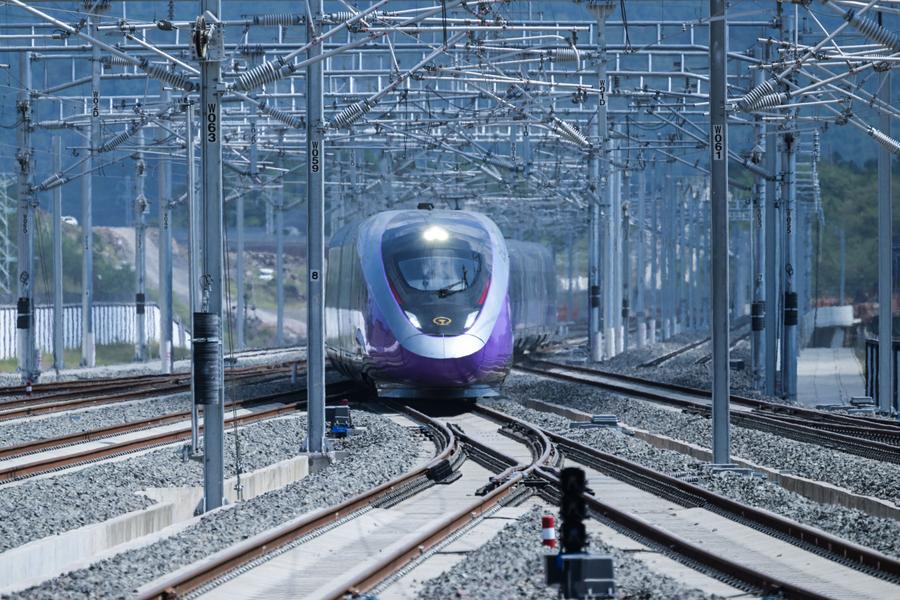From roads to railways, China builds up strength in transport sector

A bullet train pulls into Yiwu Railway Station of the Hangzhou-Wenzhou high-speed railway in Yiwu, east China's Zhejiang Province, Sept. 6, 2024. (Photo by Lyu Bin/Xinhua)
BEIJING, Oct. 7 (Xinhua) -- As a Chinese saying goes, if you want to get rich, build roads first. Since the founding of the People's Republic of China, the country has been committed to building a robust transport network, connecting remote villages with bustling metropolises and facilitating the smooth flows of people and goods.
In its latest efforts to boost regional connectivity, China put into operation two sections of railway in the Guangdong-Hong Kong-Macao Greater Bay Area in May, marking the opening of the longest intercity railway route in the area.
The 258-kilometer-long line, linking cities like Huizhou, Dongguan, Guangzhou, Foshan and Zhaoqing, underscores China's dedication to enhancing transport across its vast expanse.
From underdeveloped infrastructures to a sprawling network, China's transport sector has now evolved into a multi-faceted and integrated system over the past 75 years, featuring high domestic and international connectivity.
STRETCH AFAR
China's railways set a new record in daily railway passenger trips, with over 21 million passenger trips handled on Tuesday, the first day of the weeklong National Day holiday, highlighting the country's impressive capacity and reliability.
Roads remain the most popular mode of transportation in China, and the country's road network has witnessed an outstanding growth. From a mere 80,700 kilometers in the early days when the country was founded, its total road length has now surged to over 5.4 million kilometers.
In particular, the length of roads in rural areas reached about 4.6 million kilometers by the end of 2023, accounting for 84.6 percent of the total. With more roads built, travel has no longer been a luxury for residents in isolated and remote areas, greatly boosting their mobility and bringing more job opportunities.
China now also has the world's busiest operational railway network, stretching over 160,000 kilometers. This represents a phenomenal leap from the 21,000-kilometer-long railways back when the country was founded.
Rapid urbanization has turbocharged the expansion of the comprehensive transportation system in Chinese cities. With over 10,000 kilometers of operational urban railways and 259 certified civil aviation airports, Chinese cities have built robust transport capacities to cater to the growing needs of their urban population.
Logistics has been made more efficient with the fast growth of its multimodal transport, which has propelled China to become the world's leading express delivery hub for the past 10 years, with per capita express delivery parcels in the country exceeding 90 pieces in 2023.
GREEN, SMART TRANSPORT
China has pursued the high-quality development of its transport sector, prioritizing sustainability and intelligent transformation.
The country has promoted the use of new energy vehicles, with data showing that over 530,000 electric buses and 1 million logistics vehicles were operating in urban areas as of the end of 2023.
New energy vehicles (NEVs) have gained great popularity among Chinese car owners. Industrial data showed that the penetration rate of NEVs in the country stood at 44.8 percent in August, meaning that two out of every five cars sold in China are now powered by new energy.
Smart and digital technologies are transforming the sector. China has stepped up efforts to make railways, roads, shipping lanes, civil aviation and postal services more intelligent.
The country leads the world in the scale of automated container terminals already built or under construction. Digital transport services have become part of people's everyday life, with online taxi booking services handling over 30 million orders daily and bicycle rental services available in more than 400 cities.
Another force reshaping the transport landscape is autonomous driving technologies.
At a transport expo last month, China's ride-hailing platform Didi Chuxing showcased their latest autonomous driving technologies. With remote sensors on car roofs and powered by software, the company's innovative system can automate the entire driving process from order dispatching, passenger pickup to navigating routes.
Supported by multiple intelligent operation centers, the system could meet the needs of autonomous driving vehicles, according to Li Jian, who heads Didi's autonomous driving operations.
Looking forward, the development of China's transport network will be guided by clear roadmaps. According to an over-arching plan on transport unveiled in 2021, the country aims to establish a modern, high-quality, and comprehensive national transport network that is convenient, cost-effective, green, intelligent and safe.
The network will feature higher domestic and international connectivity, multi-channel access to major cities, and effective coverage of county-level nodes, the plan said.
Photos
Related Stories
- A glimpse of transportation development in Henan, C China
- World's leading transport expo highlights smart, green solutions
- China's summer rush ends with record high railway passenger trips
- Main structure of Asia's largest underground transportation hub completed
- China to host global forum on deepening transportation cooperation
Copyright © 2024 People's Daily Online. All Rights Reserved.









